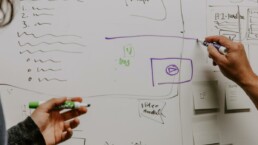Simplicity vs Complexity: Part 1 – Organizational Applications

Photo by Kaleidico on Unsplash
As growth and development in the human body bring about natural, healthy complexity, so growth of customer base, product lines, and employee count naturally increases complexity of the organization.
The Cost of Complexity
This increase in complexity incurs costs in several different ways.
Government agencies issue and enforce standards for quality, privacy, and public safety. While this is generally supported by society, the day-to-day implementation results in additional administration and expense. Regulations may yield a safer workplace but result in a less flexible work environment. This environment demands higher skill levels for employees, affecting wages and profits. These additional costs may pose barriers to smaller organizations, thereby reducing competition and increasing prices.
To understand and guide a larger organization management requires more sophisticated reporting. Additional software and systems required to track and report on this complexity adds cost for software licensing, staff training and more complex procedures. For example, a small charity may track some basic donor information, allocate gifts to a single or small number of funds, and issue simple receipts. However, as the charity engages in more projects and offers more methods of accepting donations, the systems and staff required increases, sometimes resulting in a reduction of operational efficiency. Reporting then requires additional time to prepare and understand.
Technology solutions promise increased operational efficiency. Unfortunately, the systems are frequently more complex to use, require additional dedicated staff to manage and secure, and incur higher licensing costs. The increasing risk of security threats over recent years requires more effort and investment to protect systems and insure the organization against data breaches.
Every industry has its own unique regulations, such as the safety regulations in trucking, or in the food service sector. Registered charities are typically more complicated than a similar sized for-profit organization. Even a modest sized registered charity will likely need to deal with fund accounting to properly track gifts to, and spending from, specific projects. For example: a charitable foundation with less than $1,000,000 in revenue may need to track dozens of restricted project funds, while the accounting for a similar-sized for-profit corporation would remain straightforward.
Managing the complexity challenge
Increasing complexity is a natural result of organizational growth. Manage the complexity by identifying and then simplifying processes when complexity does not add value.
Find Efficiencies
Finding ways to efficiently meet reporting requirements provides a competitive advantage. For example, in the trucking industry, managing fuel tax reporting across multiple jurisdictions is complex. Hiring more staff and adding more software provides no apparent value to customers. Therefore, spending beyond the minimum required to meet baseline reporting requirements is unnecessary.
The same is true for charities. Find the most cost-effective ways to correctly and quickly handle regulatory reporting requirements. An example is the requirement to file an annual Registered Charity Return. Either have a volunteer Board member with CPA experience handle this as part of their role, or source it out to a CPA firm who has the dedicated software and experienced staff. While it is important to complete this report correctly, avoid investing anything more than necessary in this task that needs to be done only once each year.
Recognize Process Phases
Recognizing the phases of a process can help the organization discover efficiencies. As an individual works at tasks, there are often three phases. These can be seen in the example of reconciling a bank account. Phase one involves assembling documents like bank statements, starting the software, opening any forms, and general set up. This may only take a minute but is important to recognize. The transaction phase involves matching transactions and general problem solving. The final phase involves closing off. This includes running and filing reports then finally, closing the software.
In manufacturing, these cycles have been understood for many years and considerable effort is invested to improve efficiencies. Intentionally planning tasks can yield significant productivity improvements. Reduce the number of start and finalize phases by grouping tasks during the day. This has the additional benefit of increasing mental focus on the reduced number of tasks that are to be accomplished at one time.
Improve Role Descriptions
Organizations that recognize processes and reduce transitions or “frame shifts”, can design better job or role descriptions and office environments. A common error is to set up a receptionist to work on data entry while answering the phone or working at a public desk. The staff member is constantly dealing with unexpected frame shifts. This loss of focus contributes to errors and slows progress.
If the organization does require this type of situation, then recognize and bridge this challenge. Use a ruler on the page to mark the spot for data entry so lines are not inadvertently missed. Attempt the task without interruption to understand how much faster it could be accomplished. This may be why many office workers have enjoyed working from home during the COVID-19 pandemic. The large number of interruptions, or frame shifts, while working from home are also a reason many individuals say they did NOT enjoy this work setting.
Conclusion
In a recent McKinsey report, the consulting firm advises, “The answer is not to make an organization as simple as possible, but rather to eliminate the complexity that makes it hard to get things done and creates little value. If complexity can (be) seen not as a problem to be eliminated but as a challenge to be managed and even exploited, businesses can generate additional sources of profit and competitive advantage.” Mckinsey.com
Join us in Part 3 to explore helpful time management tools for individual effectiveness and the myth of multitasking. In part 4 we will explore anchoring ourselves in the presence of this tension.
